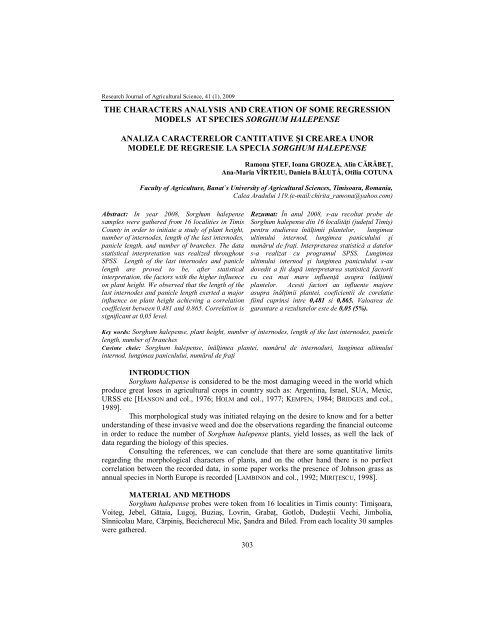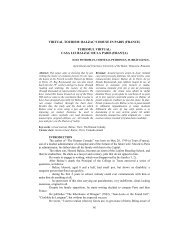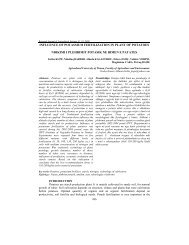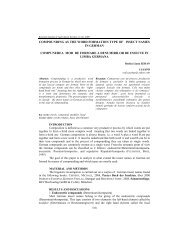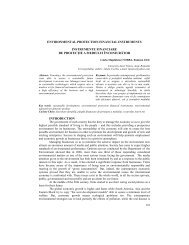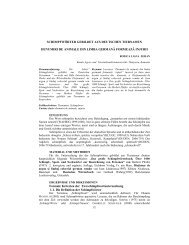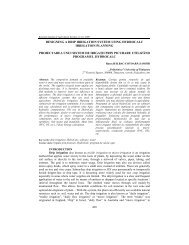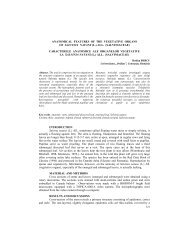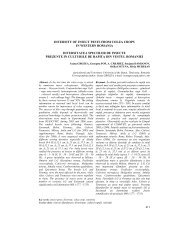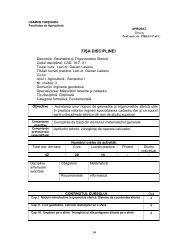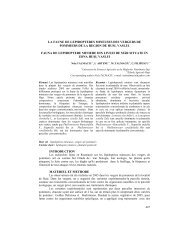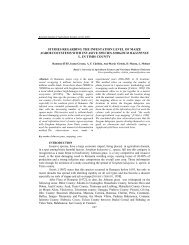03 Stef Ramona.pdf
03 Stef Ramona.pdf
03 Stef Ramona.pdf
Create successful ePaper yourself
Turn your PDF publications into a flip-book with our unique Google optimized e-Paper software.
Research Journal of Agricultural Science, 41 (1), 2009<br />
THE CHARACTERS ANALYSIS AND CREATION OF SOME REGRESSION<br />
MODELS AT SPECIES SORGHUM HALEPENSE<br />
ANALIZA CARACTERELOR CANTITATIVE ŞI CREAREA UNOR<br />
MODELE DE REGRESIE LA SPECIA SORGHUM HALEPENSE<br />
<strong>Ramona</strong> ŞTEF, Ioana GROZEA, Alin CĂRĂBEŢ,<br />
Ana-Maria VÎRTEIU, Daniela BĂLUŢĂ, Otilia COTUNA<br />
Faculty of Agriculture, Banat`s University of Agricultural Sciences, Timisoara, Romania,<br />
Calea Aradului 119.(e-mail:chirita_ramona@yahoo.com)<br />
Abstract: In year 2008, Sorghum halepense<br />
samples were gathered from 16 localities in Timis<br />
County in order to initiate a study of plant height,<br />
number of internodes, length of the last internodes,<br />
panicle length, and number of branches. The data<br />
statistical interpretation was realized throughout<br />
SPSS. Length of the last internodes and panicle<br />
length are proved to be, after statistical<br />
interpretation, the factors with the higher influence<br />
on plant height. We observed that the length of the<br />
last internodes and panicle length exerted a major<br />
influence on plant height achieving a correlation<br />
coefficient between 0.481 and 0.865. Correlation is<br />
significant at 0,05 level.<br />
3<strong>03</strong><br />
Rezumat: În anul 2008, s-au recoltat probe de<br />
Sorghum halepense din 16 localităţi (judeţul Timiş)<br />
pentru studierea înălţimii plantelor, lungimea<br />
ultimului internod, lungimea paniculului şi<br />
numărul de fraţi. Interpretarea statistică a datelor<br />
s-a realizat cu programul SPSS. Lungimea<br />
ultimului internod şi lungimea paniculului s-au<br />
dovedit a fii după interpretarea statistică factorii<br />
cu cea mai mare influenţă asupra înălţimii<br />
plantelor. Acesti factori au influente majore<br />
asupra înălţimii plantei, coeficientii de corelatie<br />
fiind cuprinsi intre 0,481 si 0,865. Valoarea de<br />
garantare a rezultatelor este de 0,05 (5%).<br />
Key words: Sorghum halepense, plant height, number of internodes, length of the last internodes, panicle<br />
length, number of branches<br />
Cuvinte cheie: Sorghum halepense, înălţimea plantei, numărul de internoduri, lungimea ultimului<br />
internod, lungimea paniculului, numărul de fraţi<br />
INTRODUCTION<br />
Sorghum halepense is considered to be the most damaging weeed in the world which<br />
produce great loses in agricultural crops in country such as: Argentina, Israel, SUA, Mexic,<br />
URSS etc [HANSON and col., 1976; HOLM and col., 1977; KEMPEN, 1984; BRIDGES and col.,<br />
1989].<br />
This morphological study was initiated relaying on the desire to know and for a better<br />
understanding of these invasive weed and doe the observations regarding the financial outcome<br />
in order to reduce the number of Sorghum halepense plants, yield losses, as well the lack of<br />
data regarding the biology of this species.<br />
Consulting the references, we can conclude that there are some quantitative limits<br />
regarding the morphological characters of plants, and on the other hand there is no perfect<br />
correlation between the recorded data, in some paper works the presence of Johnson grass as<br />
annual species in North Europe is recorded [LAMBINON and col., 1992; MIRIŢESCU, 1998].<br />
MATERIAL AND METHODS<br />
Sorghum halepense probes were token from 16 localities in Timis county: Timişoara,<br />
Voiteg, Jebel, Gătaia, Lugoj, Buziaş, Lovrin, Grabaţ, Gotlob, Dudeştii Vechi, Jimbolia,<br />
Sînnicolau Mare, Cărpiniş, Becicherecul Mic, Şandra and Biled. From each locality 30 samples<br />
were gathered.
Research Journal of Agricultural Science, 41 (1), 2009<br />
The observations were made in September when the plants reached the maturity<br />
phases, recording plant height, number of internodes, length of the last internodes, panicle<br />
length, and number of branches.<br />
The morphological characters were assessed throughout biometrical measurements<br />
with a rule. Johnson grass plant material was taken from maize field.<br />
The data statistical interpretation was realized throughout SPSS.<br />
The height of the plant was considered to be the most reliable factor. Some factors<br />
were analyzed which reveal:<br />
The existence and correlation intensity: coefficient Pearson (R), with boundaries<br />
between -1 and +1; coefficient Durbin-Watson with values between +1 and +3;<br />
Interpretation of Pearson Correlation ant testing of significance level usint T test<br />
Mean and Standard Deviation.<br />
RESULTS AND DISCUSSIONS<br />
Tabel 1 present recorded data regarding factors mean: plant height, number of<br />
internodes, length of the last internodes, panicle length, and number of branches. Doe to the<br />
major influence of length of the last internodes and panicle length we have calculated their<br />
percent in relation with plant height.<br />
Table 1.<br />
The resoults following statistical interpretation of quantitative determination of species Sorghum<br />
Halepense L (Pers) recorded in Timis county, 2008<br />
Locality Plant<br />
height<br />
Nr. of<br />
brethrens<br />
Nr. of<br />
internodes<br />
Mean values Correlations<br />
Length of<br />
last<br />
internodes<br />
(%plant<br />
height )<br />
Panicle<br />
length<br />
(%Plant<br />
height)<br />
304<br />
Nr. of<br />
branches<br />
/panicle<br />
Coef.<br />
Corel<br />
(R)<br />
F<br />
Change<br />
Sig. F<br />
Change<br />
Lovrin 162.16 2.73 6.<strong>03</strong> 28 20 45.43 0.938 45.816 0.000<br />
Sannicolau<br />
Mare<br />
Dudestii<br />
Vechi<br />
153.33 3.20 6.33 30 19 36.60 0.933 42.176 .000<br />
184.81 4.10 7.23 30 18 38.33 0.639 4,316 .009<br />
Carpinis 133.80 2.47 6.27 34 18 24.53 0.938 38.627 .000<br />
Gotlob 142.60 1.80 7.10 32 18 33.87 0.720 6.734 .000<br />
Jimbolia 145.00 2.63 6.53 29 17 30.87 0.691 5.7<strong>03</strong> .002<br />
Grabat 151.<strong>03</strong> 6.93 5.23 34 18 28.07 0.917 32.810 .000<br />
Biled 171.59 2.60 5.80 27 18 31.13 0.588 3.296 .027<br />
Sandra 160.51 1.80 8.13 29 19 31.43 0.902 27.287 .000<br />
Becicherecu<br />
Mic<br />
169.70 3.20 7.43 31 15 39.<strong>03</strong> 0.845 15.572 .000<br />
Timisoara 174.28 1.80 6.37 28 19 37.63 0.8<strong>03</strong> 11.363 .000<br />
Jebel 149.17 2.23 7.67 28 20 45.17 0.642 4.382 .008<br />
Voiteg 137.53 3.33 6.73 27 19 30.17 0.642 4,382 ,008<br />
Birda 140.<strong>03</strong> 3.83 7.13 31 19 37.40 0.851 16.424 .000<br />
Gataia 152.67 1.67 7.73 28 18 36.77 0.786 10.084 .000<br />
Strong<br />
correlation<br />
between plant<br />
height and<br />
other factors<br />
0.778(**)<br />
Length of last<br />
internodes<br />
.792(**)<br />
Panicle length<br />
0.778(**)<br />
Length of last<br />
internodes<br />
.838(**)<br />
Length of last<br />
internodes<br />
.654(**)<br />
Lungimea<br />
ultimului<br />
internod<br />
.592(**)<br />
Length of last<br />
internodes<br />
.733(**)<br />
Length of last<br />
internodes<br />
.271<br />
Panicle length<br />
.865(**)<br />
Length of last<br />
internodes<br />
.678(**)<br />
Panicle length<br />
.645(**)<br />
Panicle length<br />
.594(**)<br />
Length of last<br />
internodes<br />
.594(**)<br />
Length of last<br />
internodes<br />
.718(**)<br />
Panicle length<br />
.762(**)<br />
Panicle length
Research Journal of Agricultural Science, 41 (1), 2009<br />
Locality Plant<br />
height<br />
Nr. of<br />
brethrens<br />
Nr. of<br />
internodes<br />
Mean values Correlations<br />
Length of<br />
last<br />
internodes<br />
(%plant<br />
height )<br />
Panicle<br />
length<br />
(%Plant<br />
height)<br />
305<br />
Nr. of<br />
branches<br />
/panicle<br />
Coef.<br />
Corel<br />
(R)<br />
F<br />
Change<br />
Sig. F<br />
Change<br />
Lugoj 171.1 2.47 6.33 30 16 39.97 0.697 5.891 .002<br />
Strong<br />
correlation<br />
between plant<br />
height and<br />
other factors<br />
.481(**)<br />
Nr. of<br />
internodes<br />
The factor length of the last internodes does not recorded a high variation in all 16<br />
localities, the values oscillated between 27% and 34 % (table 1), presented as well in graphic<br />
1. The same situation is present in panicle length 15% and 20% (table 1).<br />
The mean value of plant height was recorded 133.8 – 184.81 cm.<br />
200<br />
180<br />
160<br />
140<br />
120<br />
100<br />
80<br />
60<br />
40<br />
20<br />
0<br />
Inalt. plantei<br />
L.ultim. internod<br />
Lung. panic.<br />
Gataia<br />
Voiteg<br />
Inalt. plantei L.ultim. internod Lung. panic.<br />
Figure 1. Mean values of factor with high correlation in studied localities<br />
Following correlative and regression analyses, strong connection were established in<br />
all localities.<br />
The higher correlation was achieved in locality: Lovrin – 0.938; Sannicolau Mare –<br />
0.933; Carpinis – 0.938; Grabat – 0.917; Sandra – 0.902 (table 1.), those values confirm the<br />
relation between parameters.<br />
A weaker connection was determined in localities: Biled – 0.558; Jebel – 0.642;<br />
Voiteg – 0.642; Dudestii Vechi – 0.639; Jimbolia – 0.691; Lugoj – 0.697 (table 1. and figure<br />
2).<br />
In order to establish the correlation pattern the exclusion method was used (exclusion<br />
of factors with higher significance)<br />
Based on correlation coefficients wee can affirm that the successful patterns are those<br />
who include all independent factors, therefore were selected in the synthesis table 1 as the most<br />
important.<br />
Timisoara<br />
Sandra<br />
Grabat<br />
Gotlob<br />
Dud. Vechi<br />
Lovrin
Research Journal of Agricultural Science, 41 (1), 2009<br />
0,697<br />
Lugoj<br />
0,786<br />
Gataia<br />
0,851<br />
Birda<br />
0,642 0,642<br />
Voiteg<br />
Jebel<br />
0,8<strong>03</strong><br />
Timisoara<br />
0,845<br />
Becic.Mic<br />
0,902<br />
Sandra<br />
0,588<br />
306<br />
Biled<br />
0,917<br />
Grabat<br />
0,72<br />
0,691<br />
Jimbolia<br />
Gotlob<br />
0,938<br />
Carpinis<br />
Coeficientul de corelatie ( R )<br />
0,639<br />
Figure. 2 - Correlation coefficient Pearson (R)<br />
0,938<br />
0,933<br />
CONCLUSION<br />
Variation of morphological characters was observed: plant height with variation<br />
between 82.5 and 216.5, mean 154.43 cm. Minimal and maximal height (82.5 cm repectively<br />
216.5 cm) are not to be found in papers such FLORAE ROMANIA (100-200 cm); Internodes<br />
length – varied between 4 and 11, mean 6.75 internodes/plant; length of the last internodes<br />
– values between 20 cm and 78.3 cm, mean 29.75 cm; panicle length and branches/panicle<br />
was specific to each plant wit a mean of 18.18 cm respectively 35.4 branches/panicle.<br />
According FLORAE ROMANIA vol. XII, 1972, the length of the panicle lies between 20-25 cm,<br />
from our measurement resulted that minimal length (19 cm) as well the maximal length (52.2<br />
cm) exerted differences facing the international references.<br />
A low correlation was recorded in localities: Biled 0.558; Jebel 0.642; Voiteg 0.642;<br />
Dudeştii Vechi 0.639, Jimbolia 0.691, Lugoj 0.697, resulting the fact that soil type, soil<br />
nutrients, climatic condition and other factors exerted influence on plant height.<br />
Length of the last internodes and panicle length are proved to be, after statistical<br />
interpretation, the factors with the higher influence on plant height.<br />
BIBLIOGRAFY<br />
1. ACCIARESI H., CHIDICHIMO H., 2005 - Ecophysiological response of Sorghum halepense populations to<br />
reduced rates of nicosulfuron, Pesquisa Agropecuaria Brasileira, Vol. 40, pag. 541-<br />
547;<br />
2. BRIDGES C., CHANDLER J., 1989 - A population level temperature-dependent model of seedling<br />
johnsongrass (Sorghum halepense) flowering, Weed Science, Vol. 37, pag. 471-477;<br />
3. CHIRIŢĂ RAMONA, K.F. LAUER, N. SARPE, 2004 – Die Bekampfung Der Mohrenhirse (Sorghum<br />
Halepense) in mais mit neuen Breitbandherbiziden im Banat (Westrumanien),<br />
Dud.Vechi<br />
Sannic. Mare<br />
Lovrin<br />
1<br />
0,5
Research Journal of Agricultural Science, 41 (1), 2009<br />
Zeitschrift Fur Pflanzenkrankheiten Und Pflanzenschutz, Journal Of Plant Diseases<br />
And Protection, Verlang Eugen Ulmer Stuttgart, Germania, pag. 725-731;<br />
4. HANSON C.; RIECK C., HERRON J., WITT W., 1976 - The johnsongrass problem in Kentucky. Agronomy<br />
Notes. Lexington, KY: University of Kentucky, College of Agriculture; Cooperative<br />
Extension Service, Vol. 9(4); pag. 1-8;<br />
5. HOLM L., PANCHO J., HERBERGER P., 1977 - The Worlds Worst Weeds, distribution and Biology, The<br />
University Press of Hawaii, Honolulu, Hawaii, pag. 609<br />
6. KEMPEN H., 1984 - Cotton production losses from weed competition in Kern County, a three year<br />
evaluation, In: Proceedings, Western Society of Weed Science, No. 37, pag. 47-51;<br />
7. MCWHORTER G., 1993 - A 16-year survey on levels of Johnsongrass (Sorghum halepense) in Arkansas,<br />
Louisiana, and Mississippi, Weed Science, No. 41(4), pag. 669-677;<br />
8. MIRIŢESCU M., 1998 - Cercetări asupra biologiei şi combaterii speciei Sorghum halepense (L.) Pers.,<br />
Teză de doctorat, Bucureşti;<br />
9. ORIOL IRINA, 2004 - Statistica şi analiza datelor, Editura AAP, Chişinău, 2004<br />
10. TORMA M., KAZINCZI G., HÓDI L., 2006 - Postemergence herbicide treatments in maize against<br />
difficult to control weeds in Hungary, Journal of Plant Diseases and Proctection,<br />
Supplement, pag. 781-786;<br />
11. ULUDAG A., UREMIS I., ARSLAN M., GOZCU D., 2006 - Allelopathy studies in weed science in Turkey -<br />
A review, Journal of Plant Diseases and Proctectio, Supplement, pag. 419-426;<br />
12. VASILAKOGLOU I., DHIMA K., ELEFTHEROHORINOS I., 2005 - Allelopathic potential of bermudagrass<br />
and johnsongrass and their interference with cotton and corn, Agronomy Journal, Vol.<br />
97, pag. 3<strong>03</strong>-313;<br />
307


